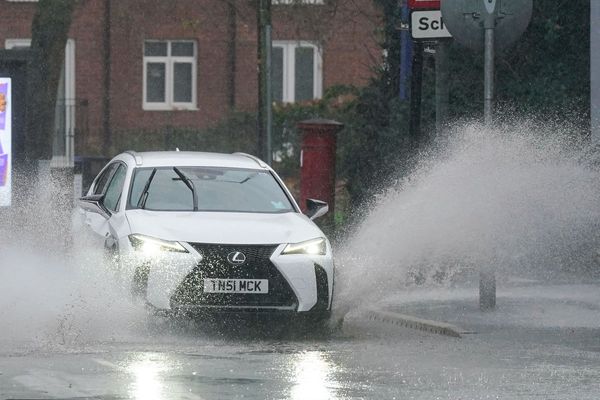
The Milton Keynes-based team fast tracked a major revision to the sidepods and engine cover last weekend, getting rid of its characteristic Mercedes-style gulleys.
The new direction was about maximising downforce because, although it is less efficient aerodynamically, that compromise did not matter at a tight and twisty track like the Hungaroring.
Ultimately, the changes proved to be a bit of a disappointment with Max Verstappen, who exclusively ran the new arrangement, feeling they had not delivered the step forward hoped for.
The lack of progress has triggered some concern from him that Red Bull could find itself on the backfoot against the increasingly strong McLaren team which is now widely acknowledged to have the fastest car in F1.
Red Bull team boss Christian Horner admitted after the race that the team now needed answers as to why progress had not been as great as it had hoped for.
“I think we have to look at all the data, now that we have it, and look at obviously where we need to optimise, and where we're not getting the performance that we obviously want to achieve,” he said.
For this weekend’s Belgian Grand Prix, Verstappen is set to go back to the old style bodywork – but not because what ran in Hungary was a disappointment.
Instead it is because Spa-Francorchamps is a track that demands extreme aero efficiency, so the high-drag version ran in Hungary would not work there.
So Red Bull in effect has taken track specific car changes – which in the past mainly just involved front and rear wing levels – to now include widescale bodywork tweaks.
Technical director Pierre Wache admitted in Hungary that there was even scope for Red Bull to change its package race-by-race.
“If the cooling level requirement and track characteristic will push us to change, yes, we will,” he said. “We try to make the quickest car…. [Changing] at each track, then it could be a possibility, yes. We don't know yet.”
What were the Red Bull changes
Red Bull took more of a radical approach than many expected with its RB20, after dominating the last two seasons.
It obviously knew that it was only a matter of time before rivals got on top of the issues that had proved problematic in the ground effect era.
This resulted in some out of the box thinking when it came to cooling, with a design that flipped its widely adopted underbite inlet arrangement on its head and saw it supplement it with a vertical inlet beside the chassis.
It not only required the radiators within the sidepod to be both stacked and tilted, it also required coolers to be mounted higher up, behind the rear leg of the halo.

This was made possible due to the much higher haunched engine cover than the shelf-like approach it took last season.
Incorporated into this new layout was a solution seen on the Mercedes W14, last year, with gulleys helping to guide the airflow downstream.
However, with Red Bull needing to cool the aforementioned high mounted coolers, it also needed additional intakes, which found a home in the gap between the halo’s rear leg and the airbox (red arrow, inset).
The team optimised this entire layout during the opening half of the season, with the introduction of another intake beside the halo’s rear leg in Japan.
The sidepod’s vertical inlet became more tapered in the central section at the Spanish Grand Prix, as further adjustments were made to the shape of the sidepod’s bodywork.

The arrival of an entirely new engine cover layout at the Hungarian Grand Prix (main image) shows that the team had also been working behind the scenes on a parallel development plan, whereby it trades some of the efficiency of the main layout for some peak gains at low speed, high downforce venues.
In order to achieve this it has taken an approach we predominantly saw under the previous regulations, whereby the bodywork would be shrink-wrapped tightly to the components housed beneath.
This not only required the bulkier bodywork to be discarded but the internal coolers to be changed too, with the boxy periscope-like fairing that’s mounted around them also removed. This also results in the use of flatter, body-hugging louvre panels.

The coolers still need feeding cool air though. So while the intakes beside the halo have been withdrawn, along with the rest of the engine cover bodywork, there’s a new location for the intakes beneath the airbox.
They are in an interesting orientation too, almost side-on to the vertical roll hoop spars, in order that they capture the air flowing into that region, without being overly harmful to the airflow’s natural downstream progression.

The change in engine cover profile also led to the team being able to redesign the upper surface of the sidepod, with a much longer and therefore deeper gulley formed in the downwash ramp section.
This has also led to a change in the lower outlet (white arrow), not only in the shape of the outer cone but also in the indentation of the trail panel, as the team looks to improve flow through that region.
An additional inlet has also been added to the underbelly of the rear cooling outlet (around the Honda logo), whilst the outlet itself is also a little larger as it no longer has the depression in the centre from the engine cover gulleys.
SIDE BY SIDE

The length and shape of the shark fin has also been altered too, with more of a traditional tip section formed above the elongated spine outlet that’s now present (red arrow).








